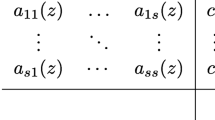Abstract
A class of general linear methods is derived for application to non-stiff ordinary differential equations. A property known as “inherent Runge–Kutta stability” guarantees the stability regions of these methods are the same as for Runge–Kutta methods. Methods with this property have high stage order which enables asymptotically correct error estimates and high order interpolants to be computed conveniently. Some preliminary numerical experiments are given comparing these methods with some well known Runge–Kutta methods.
Similar content being viewed by others
References
P. Bogacki and L.F. Shampine, A 3(2) pair of Runge-Kutta formulas, Appl. Math. Lett. 2 (1989) 1–9.
J.C. Butcher, The Numerical Analysis of Ordinary Differential Equations: Runge-Kutta and General Linear Methods (Wiley, New York, 1987).
J.C. Butcher, Diagonally implicit multistage integration methods, Appl. Numer.Math. 11 (1993) 347–363.
J.C. Butcher, General linear methods for stiff differential equations, BIT 41 (2001) 240–264.
J.C. Butcher, P. Chartier and Z. Jackiewicz, Nordsieck representation of DIMSIMs, Numer. Algorithms 16 (1997) 209–230.
J.C. Butcher and Z. Jackiewicz, Construction of diagonally implicit general linear methods of type 1 and 2 for ordinary differential equations, Appl. Numer. Math. 21 (1996) 385–415.
J.C. Butcher and Z. Jackiewicz, Implementation of diagonally implicit multi-stage integration methods for ordinary differential equations, SIAM J. Numer. Anal. 34 (1997) 2119–2141.
J.C. Butcher and Z. Jackiewicz, Construction of high order DIMSIMs for ordinary differential equations, Appl. Numer. Math. 27 (1998) 1–12.
J.C. Butcher, Z. Jackiewicz and H.D.Mittelmann, A nonlinear optimization approach to the construction of general linear methods of high order, Comput. Appl. Math. 81 (1997) 181–196.
J.C. Butcher and W.M. Wright, A transformation relating explicit and diagonally-implicit general linear methods, to appear in Appl. Numer. Math. (dy2002).
T.M.H. Chan, Algebraic structures for the analysis of numerical methods, Ph.D. thesis, The University of Auckland (1998).
J.R. Dormand and P.J. Prince, A family of embedded Runge-Kutta formulae, Comput. Appl. Math. 6 (1980) 19–26.
W.H. Enright, K.R. Jackson, S.P. N¸rsett and P.G. Thomsen, Interpolants for Runge-Kutta formulas, Math. Software 12 (1986) 193–218.
C.W. Gear, The numerical integration of ordinary differential equations, Math. Comp. 21 (1967) 146–156.
T.E. Hull, W.H. Enright, B.M. Fellen and A.E. Sedgwick, Comparing numerical methods for ordinary differential equations, SIAM J. Numer. Anal. 9 (1972) 603–637.
A. Nordsieck, On numerical integration of ordinary differential equations, Math. Comp. 16 (1962) 22–49.
L.F. Shampine and M.W. Reichelt, The Matlab ODE suite, SIAM J. Sci. Comput. 18 (1997) 1–22.
Author information
Authors and Affiliations
Rights and permissions
About this article
Cite this article
Wright, W. Explicit General Linear Methods with Inherent Runge–Kutta Stability. Numerical Algorithms 31, 381–399 (2002). https://doi.org/10.1023/A:1021195804379
Issue Date:
DOI: https://doi.org/10.1023/A:1021195804379




